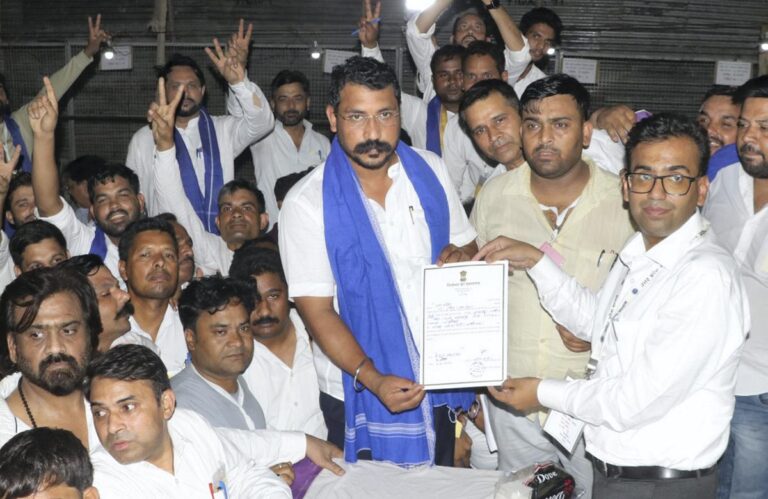The emergence of Chandrashekhar Azad as Uttar Pradesh’s new Dalit leader with his landslide victory in Nagina in the recent elections may signal the death knell for Mayawati’s Bahujan Samaj Party, which again failed to win a single seat in the state. While Azad got more than 51% of the votes, BSP’s Surendra Pal Singh barely crossed 1%. The handover of the baton could not have been more clear and unequivocal.
It reminded many of the December 2019 anti-Citizenship Amendment Act (CAA) protests. At the time, most political leaders, including Mayawati, were hesitant to be seen taking part in protests in Delhi and elsewhere. Not Azad. Just days after Ahmed Bukhari, the imam of Delhi’s historic Jama Masjid, voiced his support for the CAA, arguing that it would not affect Indian Muslims, Azad made an appearance around the time of Friday prayers at the mosque. Even as the imam peered out through the window of his mosque chamber, Azad made an impassioned appeal from the steps of the mosque, with thousands of Muslims turning their backs on the cleric and rallying behind him. It presented one of the most memorable images of the anti-CAA struggle. Azad had arrived. At least, that was the view of many who witnessed the enormous support he received from the masses that day. Two years later, time The magazine featured him as one of 100 emerging leaders, and it seemed like fate was waiting for him with open arms.

However, Azad had to wait for his chance for over four years. During that time, cases were registered against him, including his detention by Delhi Police at an event at Jama Masjid, for which police permission had not been granted. Soon after the CAA agitation, he founded the Azad Samaj Party (Kanshi Ram) and became its first MP in June this year. While his victory was heartwarming for Azad, it may prove decisive for the future politics of Uttar Pradesh. Ahead of the general elections, representatives of the Samajwadi Party met with Azad to try to bring him into the All India camp, but the meeting did not yield the expected results.

Meanwhile, Azad, while openly respecting Mayawati as a senior Dalit leader, proved he understood Kanshi Ram’s political teachings well. He understood the importance of giving voice to the Dalit community. Equally important, he understood Dalit limitations in elections. If he had dreams of making a mark at the state and national levels, he needed to unite Dalits and Muslims. It was this insight that drew him to Delhi’s Jama Masjid in 2019. It was the same ability to see into the future that drew him to Nagina constituency, which is 20 percent Dalit and 40 percent Muslim.
With the support of both Dalits and Muslims, Azad’s blueprint was complete. The masses enthusiastically nodded, catapulting him to victory and relegating the BSP candidate to fourth place. Manoj Kumar of the Samajwadi Party had to content himself with third place and about 10% of the votes. The results show why the Samajwadi Party has cause for concern despite its major comeback in the 18th Lok Sabha elections. Historically, the party has relied on the support of Muslims and Yadavs for success. This time, it has added other OBCs and non-Jatav Dalits. This new confluence has worked out everywhere except Nagina. Azad’s attempt to bring Dalits and Muslims in the same direction may pose a challenge similar to that presented by Mayawati, and before that, Kanshi Ram.

With Nagina, Azad heralded the emergence of a new Dalit leader to carry on the legacy of Kanshi Ram. This may mean the end of Mayawati’s story in the state. For over four decades, the BSP has been seen as the voice of Dalits. Mayawati built the party with the support of the Dalit community but was smart to bring Muslims into the party and then, for a brief period, Brahmins in when she formed a rainbow coalition ahead of the 2007 state elections.
The success of 2007 ignited hopes and ambitions. People started whispering that Mayawati could rise to even greater heights in politics. “My dream is not to become president but to become prime minister,” she had once joked. She spoke prematurely. When her runaway momentum was halted in Uttar Pradesh, first by the Samajwadi Party in 2012 and then by Yogi Adityanath-led BJP for two consecutive terms, the BSP’s fortunes took a dire dip. It was a steep decline, from 206 MPs in 2007 to just 19 in 2017 and one in the state assembly by 2022. And zero MPs in 2024. While Mayawati seeks reasons for her defeat, Azad seems ready for a long break.
This is a premium article available only to our subscribers. To read over 250 premium articles every month,
You’ve reached your limit for free articles. Support quality journalism.
You’ve reached your limit for free articles. Support quality journalism.
You have read {{data.cm.views}} from {{data.cm.maxViews}} Free articles.
This is the last free article.

